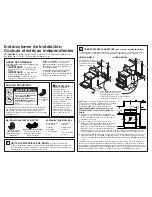
ELECTRICAL REQUIREMENTS
WARNING:
This appliance must be properly grounded.
WARNING:
All new constructions, mobile homes, recreational vehicles and installations
where local codes do not allow grounding through neutral, require a 4-conductor UL-listed range cord.
WARNING:
To prevent fire or shock, do not use an extension cord with this appliance.
WARNING:
To prevent shock, remove house fuse or open circuit breaker before
beginning installation.
We recommend you have the electrical wiring and hookup of your range connected by a qualified
electrician. After installation, have the electrician show you how to disconnect power from the
range.
You must use a single-phase, 120/208 VAC or 120/240 VAC, 60 hertz electrical system. If you
connect to aluminum wiring, properly installed connectors approved for use with aluminum wiring
must be used.
Effective January 1, 1996, the National Electrical Code requires that new construction (not
existing) utilize a 4-conductor connection to an electric range. When installing an electric range
in new construction, mobile home, recreational vehicle, or an area where local codes prohibit
grounding through the neutral conductor, refer to the section on four-conductor branch circuit
connections.
Check with your local utilities for electrical codes which apply in your area. Failure to wire your
oven according to governing codes could result in a hazardous condition. If there are no local
codes, your oven must be wired and fused to meet the National Electrical Code, NFPA No.
70 – latest edition, available from the National Fire Protection Association.
This appliance must be supplied with the proper voltage and frequency, and connected to an
individual, properly grounded, 40 amp (minimum) branch circuit protected by a circuit breaker
or time-delay fuse.
Use only a 3-conductor or a 4-conductor UL-listed range cord. These cords may be provided with
ring terminals on wire and a strain relief device.
A range cord rated at 40 amps with 125/250 minimum volt range is required. A 50 amp range
cord is not recommended but if used, it should be marked for use with nominal 1
3
⁄
8
″
diameter
connection openings. Care should be taken to center the cable and strain relief within the
knockout hole to keep the edge from damaging the cable.
The rating plate is located on the oven frame or on the side of the drawer frame.
3
Rating plate
SINGLE OVEN
Rating plate
DOUBLE OVEN
POWER CORD AND CONDUIT INSTALLATION
Remove wire cover (on the back of range) by removing screws using a 1/4” nut driver.
Do not discard these screws.
For power cord and 1” conduit only,
remove
the knockout ring (1
3
⁄
8
″
) located on bracket
directly below the terminal block. To remove
the knockout, use a pair of pliers to bend the
knockout ring away from the bracket and
twist until ring is removed.
For 3/4” conduit installations only
, purchase a squeeze connector matching the diameter
of your conduit and assemble it in the hole. Insert the conduit through the squeeze connector
and tighten. Allow enough slack to easily attach the wires to the terminal block.
NOTE:
Do not install the conduit without a squeeze connector.
The squeeze connector MUST
be installed before reinstalling the rear range wiring cover.
D
B
A
4
Wire cover
5 screws to
remove
wire cover
Knockout
ring in
bracket
Knockout ring
removed
Retaining
tabs
Back of range
Terminal block
(appearance
may vary)
Terminal block cover
Screw to
remove
terminal
block cover
Back of range
SINGLE OVEN
DOUBLE OVEN
For power cord installations only
(see the next step if using conduit),
assemble the strain relief in the hole.
Insert the power cord through the strain
relief and tighten. Allow enough slack
to easily attach the cord terminals to
the terminal block. If tabs are present at
the end of the winged strain relief, they
can be removed for better fit.
NOTE: Do not install the power cord
without a strain relief. The strain relief
bracket MUST be installed before
reinstalling the rear range wiring
cover.
C
Power cord
Strain relief
Terminal
block
Bracket
Squeeze
connector
Terminal block
Conduit
Bracket
PROCEED TO STEP 5 OR 6.


























